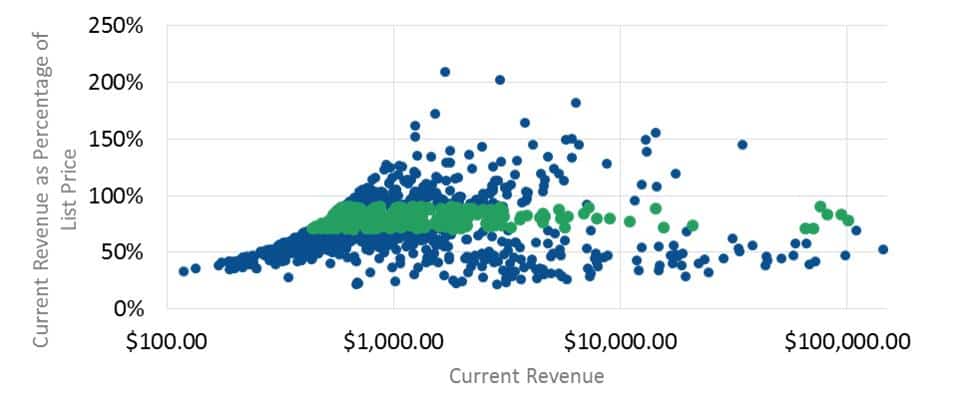Higher Rate
acceptance for price changes among customers
The Challenge
This project had three major challenges that needed to be addressed in order to ensure a successful re-launch.
1. Data Management:
The content category that was being restructured had around 2,000 customers spread across different industries including manufacturing, research, finance and investment companies. In order to develop a compelling strategy all of the customer data would need to be merged, reorganized and managed.
2. Developing a Winning Strategy:
A new pricing strategy that captured the increased value customers would get from the consolidation change needed to be developed. The strategy also needed to capture new revenue where additional value was provided while also mitigating the risks associated with migrating more sensitive customers.
3. Ensuring Successful Implementation:
Finally, the client was unsure what guidance the sales teams should receive, as they knew achieving list price would be challenging for many customers who were on discounted deals and any reasonable target price would depend on a number of factors specific to that individual client.
Information Publishing Industry
After restructuring and consolidating a product portfolio it can be difficult to set new prices that communicate value and are accepted by customers. This client, a global information content provider that provides collated information and data for a number of sectors, had received feedback, from their customers, that their product portfolio was too complex.
In response the client had made the decision to simplify their offering by consolidating products and building new products, which were bundles of existing content. They set their prices for these new offerings by evaluating past rate cards, competitor benchmarks and changes in the value that these products would deliver to customers. However, the client was finding it difficult to assess whether their customers would accept their price changes.
Pricing Solutions was asked to analyse the client’s transactional data to model the price changes for each individual customer and create a strategy for how to migrate customers to the new pricing structure. The project was completed in 5 weeks from initial briefing to presenting final deliverables.
Publishing Pricing Case Study
Building a Solution that Fits
The first stage of the project was building the data set, Pricing Solutions consultants worked with the IT team to extract data from SAP and salesforce. This was combined with excel based reference sheets and pricing rate cards to build one complete data set. Although the data set was not perfect the Pricing Solutions team was able to overcome this to create a data set that would continue to provide actionable pricing insight to the client.
The second key stage was getting the correct assumptions in place in order to correctly map the customer’s current purchases to their likely purchases after the product restructuring. With consolidation of products this is simple, however when products are being split up and new products are being created the path to migration becomes more complicated.
Pricing Solutions worked with the client team to develop and test the mapping assumptions; ensuring that the whole team was happy with the final map of products. The sales force found this invaluable as they finally had quick access to information on what customers were likely to want in the new structure, something they would have had to develop on their own.
Once customer purchases were mapped the differences between customer’s current expenditures and new target prices were calculated. By displaying the spread of differences the team saw 9 distinct groups of purchasers who would be impacted by the restructure in vastly different ways (Some would pay more, some less and others expenditure would remain relatively constant). It was clear that a, “one price change” approach for all customers would not work.
Price targets for each group were set by the sales management team so the sales force could focus their efforts on their biggest revenue and highest risk accounts. For customers more than 30% below their target price the increase would have been too drastic and so minimum percent price increases were set to ensure that, over time, these customers paid a fair price.

Above: The green band of customers whose current revenue is at 70-90% of the new list price were given one particular pricing strategy, while different strategies were developed for the rest of the customers.
The Result?
The sales team was able to use this strategy to propose tailored price changes to customers. This led to a higher rate of acceptance for price changes than a general approach would have had. Customer churn was also minimised by not enforcing price increases on customers who were already paying the highest prices.
The analytical tools developed during the project were handed over the client so that they could monitor future pricing performance and evaluate future pricing changes themselves. As other divisions of the company have conducted product migrations they have reached out to Pricing Solutions to support their process and ensure success.
The Pricing Solutions Difference
Ultimately, Pricing Solutions’ hands-on, tailored approach and depth of industry experience made this project a success. Strong data analytics capabilities and experience, allowed the team to manage and refine information from the client.
Finally, the client felt that previous experience in migration models and advising on best pricing practices also set Pricing Solutions apart from the competition.